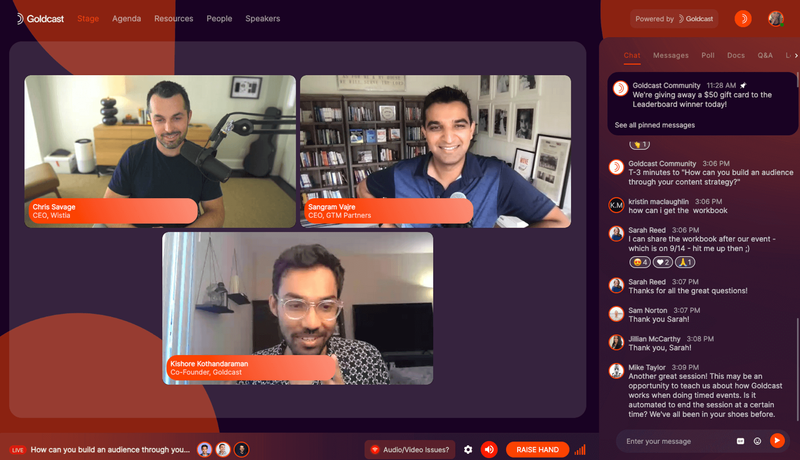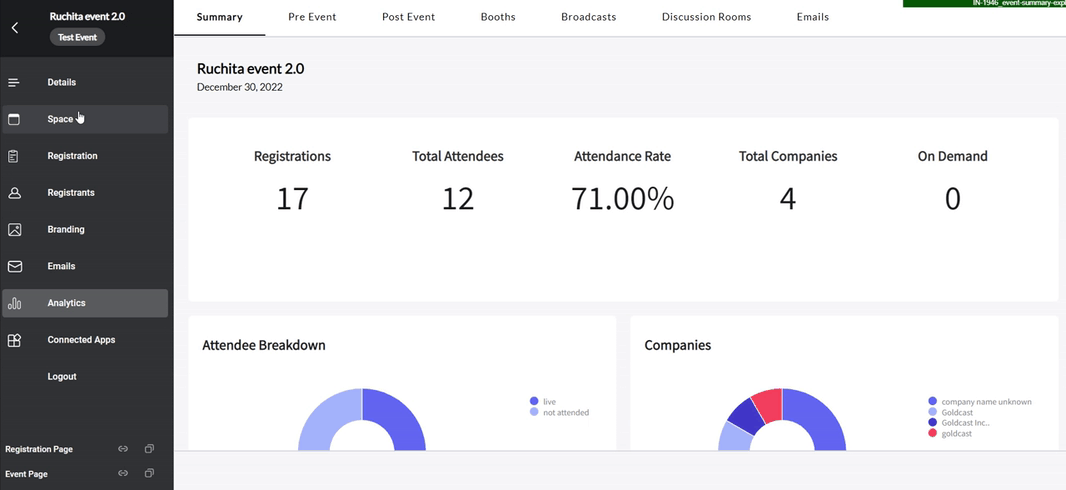Activate Channel Revenue: 5 Tips for Wildly Successful Partner Events

Maximize Your Marketing ROI
Join 10,000 other marketers already getting the best tips on running engaging events that boost pipeline and create raving fans.
When you're looking to make the biggest impact on channel revenue, it's a great idea to think beyond your own company. There are probably a handful of strategic allies in the B2B space whose offering complements your own; teaming up with them to put on awesome digital events will maximize reach — and potential revenue — for both of you!
Even if you're already engaged with partners, you may be interested in learning how to improve the way you run partner events. Adding more people to the decision-making process can lead to some challenges—but things don't have to be stressful! By being proactive and planning ahead, you can minimize any speed bumps along the way.
Whether you're new to partnerships or a seasoned team player, there's something for you here!
Read on to learn:
- Using digital events to drive partner engagement webinar
- To-partner and through-partner events
- 5 best practices for running successful partner events
- Partner events don't have to be complicated
Using digital events to drive partner engagement webinar
For our recent Rock Your Funnel series, Goldcast co-founder Kishore Kothandaraman hosted the webinar Using Digital Events to Drive Partner Engagement and Activate Channel Revenue and spoke with:
- Karen Newnam, Senior Director, Americas Partner Marketing at Nutanix
- Philip Grotto, Global Head of Partner Marketing at Bloomreach
- Alex Stanton, Senior Director, Partner Marketing at Arctic Wolf
These seasoned partner marketing experts discussed how their companies handle to-partner and through-partner events. They shared examples of successful events and walked us through the finer details of each type of partner event, as well as how they measure partnership success.
And, yes, we talked about how to tell if people are just there for the free drinks or swag! Check out the full session below to catch up. ⤵️
✨ Psst: You can access all of our Rock Your Funnel content on-demand now!
To-partner and through-partner events
All of our panelists talked about the power of to-partner events, which are events designed to gather your partners together in the same space and build a community together. Maybe you're talking about industry best practices, or perhaps you're thanking your trusted partners for their service.
Whatever your intent with to-partner events, these are very different from through-partner events, when you work with your partners to put on an event for a target audience.
Here at Goldcast, our focus has primarily been on through-partner events, so that's what we'll hone in on here with our advice. However, if you're interested in learning more about to-partner events, definitely check out the full webinar!
How partner events unlock channel sales
Before we start, let's make sure we're all on the same page when it comes to partnerships and channel sales.
Channel sales refers to "selling through partners" and, according to Salesforce, represents 75% of the world's commerce.
That's right: the majority of the world's purchases come through channel sales. Think about it: When you buy something from Amazon, that's a channel sale. You're not purchasing directly from the manufacturer of the product itself; you're buying through Amazon.
As a B2B business, your goal with channel sales is to collaborate with companies who can help you unlock new (but highly relevant) audiences—while you're doing the same for them. Channel sales is a broad term, but our focus today is on how to use digital events as part of your strategy.
Here’s why virtual event partnerships work so well:
- More partnerships = More revenue! In HubSpot's 2022 State of Partner Ops and Programs report, almost half of companies said 26% or more of their company’s revenue came from partnerships. By linking up with a relevant partner, you share resources—both tangible and intangible—and compound the value of your event content, which leads to more revenue down the line.
- Bolster your on-demand content library. Your partnered events will likely have more budget and more attendees, which can add up to more engaging, memorable events stacking up in your evergreen virtual library! Plus, your partners will be able to host the same content in their resource libraries, which leads to more people learning about your brand long after the event ends.
- Maximize your reach. Partners can help you amplify your message in existing markets as well as move into new, untapped segments. Look at this case study as an example: REVIEWS.io, a UK-based reviews company, was able to expand into new territories—where no one knew about the company—thanks to selective partnerships.
As a B2B business, your goal with channel sales is to collaborate with companies who can help you unlock new (but highly relevant) audiences—while you're doing the same for them.”
How to set goals for your partner events
Setting goals for your partner events will be similar to the way you set goals for your other events, with an important caveat: Your goals should align with those of your partner. Be clear in communicating each of your goals upfront so that you design your event with those in mind.
Your goals will also vary, depending on which partner you're working with. For example, you might set a higher goal for event registrations if you're working with a well-known name in the industry versus if you're partnering with a newer-to-market brand.
Alex recommends asking these four questions:
- What is the objective that we want to achieve with this partner event? Sometimes you might have a specific sales or conversion target, and other times you might want to partner specifically for more brand recognition. That's okay! The important thing is that you're aware of your objective.
- What do we consider success? In other words, what's a best case scenario for you after the event?
- What are we trying to get our partners to do? We'll talk about partner communication soon, but it's so critical that you know exactly what you want from these partner relationships.
- Are there any change management considerations? For example, if you're implementing a new process on your side, you need to tell your partner about that and walk them through it so they're prepared.
Then, use these metrics as starting points for goal-setting:
- Event registrations: You'd likely hope to see more registrations than usual if you're working with a partner to amplify your efforts.
- Event attendees: Keep in mind that your attendee:registrant ratio may still be similar to what you're used to. Just because people are signing up for a partner event doesn't mean they'll actually show up; they may not be able to make it, or they may prefer to watch the on-demand recording.
- Quality of registrants and attendees: You can use lead scoring to determine how "warm" different leads were.
- Pipeline generated: How many prospects are now on your radar, thanks to this event?
- Revenue generated: We all want our companies to make money! Sourced and influenced revenue are the most common KPIs set for partnerships in general. Whether this makes sense for your event will depend on the type of event it is, of course.
Remember: Your ultimate goal is to boost revenue for both you and your partner. Skim the goals above with that in mind. Do the benchmarks you set make sense with that revenue-generating destination in mind?

5 best practices for running successful partner events
In our years of working with other companies to amplify our brand awareness, we've learned a few things. Here are five of our best tips for maintaining smooth partnerships and making sure your events meet your goals!
1. Choose your channel partners wisely
There are many companies out there, but only a few will be the right fit for you.
Remember: Your goals must align with your partner's. Have those discussions early on, and pay attention to any signs or red flags that you're not on the same page.
Other things to pay close attention to are your partner's competency, work ethic, and consistency. Are they showing up on time and prepared for meetings? Are they following up on items they say they will? Do you feel good about the work they're doing?
You want to feel comfortable giving some of the control to your partner, and you'll only be able to do that if you trust them.
Here are some things to look for in your partnerships:
- The same target audience and ideal customer profile (ICP)
- A similar sized (or slightly larger) audience and following
- A complementary product or offering
- Compatible brand message or value proposition
- A mutual strong desire to see real growth and success from the partnership
When it comes to partnerships, quality is better than quality! Going deep with a few meaningful partnerships will likely yield better results than casting a wide net and running with whatever you can get.
2. Make it easy for your partners with regular check-ins and ready-to-post content
If you want your partnerships to thrive, a great tip is to make things super easy for them!
Some suggestions:
- Schedule regular check-ins that keep things moving forward and give people a chance to ask questions.
- Make unique links for each partner and then track how many registrants are tied to each one.
- Create all social graphics (and even captions!) for your partners to share. You can also develop email templates and banners for partners to use in their email marketing efforts.
Staying on top of these things shows your partner that you're a solid company to work with. By being proactive, you're demonstrating you're equally committed to their success and making it easy to track the value of your partnership over time.
If you want your partnerships to thrive, a great tip is to make things super easy for them!”
3. Establish partner responsibilities ahead of the event
To minimize confusion and frustration, set expectations about who will do what before the partnership begins. This should cover everything from how you share information to the ways you want to follow up with attendees after the event.
Being honest with each other at the beginning of the partnership is so important." - Philip Grotto, Global Head of Partner Marketing, Bloomreach
Lead sharing is a big one here. How do you want to handle this information after the event? You can share the entire list with your partner, in exchange for a sponsorship fee. Or you can set up a lead sharing system that sends the list only after your partner brings a certain number of leads to the event.
Maybe you'd rather agree to share one lead in exchange for every new attendee that registers for your event. Or, you want to only share the leads who attended a specific partner-led or sponsored session.
If none of these suggestions sound good, you can also work out your own way of doing it!

Beyond lead sharing, you'll also need to think about these event marketing tasks:
- Event promotion: Who shares what—and on which channels? How often are you each posting in the weeks/days leading up to the event? Who’s in charge of creating and sharing the media pack? What role will video play in your event marketing efforts?
- Branding and design: Who’s taking the lead on design and branding? How will partners be represented within the branding? Where will logos/brand names appear?
- Roles during the event: Who takes on which responsibilities? Will either partner be expected to take on any facilitation/speaker/host roles?
- Lead follow-up post-event: Who's following up? How will you track follow-up efforts? When will follow-up take place?
- Event analysis and reporting: Who’s in charge of reporting? Which metrics do you need to track? Who will have access to the data? How and when will it be shared?
It might seem like a lot to delegate tasks out in advance of your event, but this will be more efficient for everyone in the long run. Being prepared means you're respecting everyone's time and cuts out any potential for frustration after the event. Not only that, but you're making sure that promo materials are taken care of, leads are nurtured, and important metrics are analyzed!
4. Create a cohesive ecosystem
Even though you're working with a partner company, you want things to be seamless. Here are three major things to consider doing:
- Gather lead data in a central place. No matter where your leads come from, their data needs to end up in the same place in order to generate the insights you and your partners need. Think: spreadsheets or data collection solutions (if you’re a Goldcast user, we collect attendee and account-level data for you automatically!).
- Unify event branding. Whoever creates the branding should make sure it can be used by either partner without throwing any of your audience members off. That means choosing colors and designs that would work for both of you, or coming to an agreement on a new design for the partnered content.
- Make it easy for partners to access materials. Whether it's a document in which you link out to every resource they might need or a shared drive, make it a cinch for partners to grab press releases, suggested wording, and more without having to ask you every time they're looking for something.
5. Analyze your event data
You didn't think we could write a post about digital events without talking about data, did you?
Every B2B marketer knows that powerful data matters—and partnered events are no different! You'll want to gather crucial data around your event goals, as well as deep account-level insights, at every stage of the event marketing journey. This will help you see what worked well (and what didn't), which you can use to inform future partnerships.

Here are a few key metrics to track:
- Partner session attendance. Who attended each session and for how long? How does this compare to your standard session attendance?
- Attendee engagement. How active were people throughout the event? Did people reach out to chat 1:1 with support staff? Did they ask questions, respond to polls, or take any other actions? (Hint: Check out this post for some advice on boosting attendee engagement!)
- Total number of leads. How many leads did each partner bring to the table?
- Post-event resource downloads. If people were downloading documents, guides, or other resources that you mentioned during the event, that's a great sign they're interested and want to learn more!
- Product demos or live sales clicks. Same thinking as above—the more people that seek out more information about your product or reach out to your sales team, the merrier!
Once you organize your data and get clear on what insights it's offering you, it's time to huddle with your partners and talk about everything. You already know who's going to follow up (remember Step 3?), so identifying next steps will be super straightforward!
Partner events don’t have to be complicated
At this point, it almost goes without saying that a thoughtful, robust partnership marketing strategy will make everyone's lives easier—and, hopefully, boost everyone's revenue!
From setting expectations early on in the partnership process to analyzing post-event data in meaningful ways, there are many ways you can provide value to your partner and ensure your future success.
And if you're looking for a B2B-specific digital event platform to help you create and host customizable, engaging events, Goldcast is here for you! Our true-to-you event branding will help you and your partners create a unique, dazzling digital event experience. After the event, you'll get all the data you need, right in the systems you already use.
Ready to learn more? Schedule your personalized demo today to see how we can improve your future partnership events!

Transform Your Video Marketing with AI
Stay In Touch
Platform
Resources
© 2025 Copyright Goldcast, Inc. All rights reserved.





 Upcoming Events
Upcoming Events Event Series
Event Series On-Demand Events
On-Demand Events

